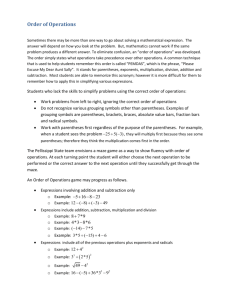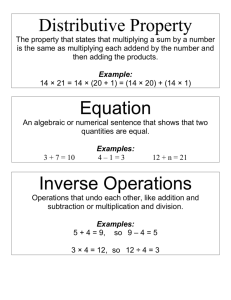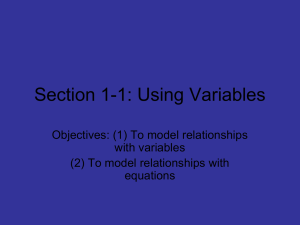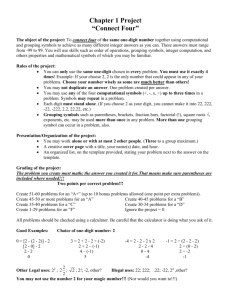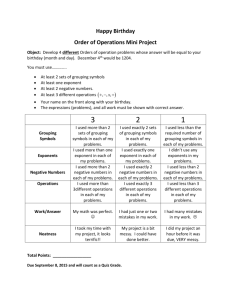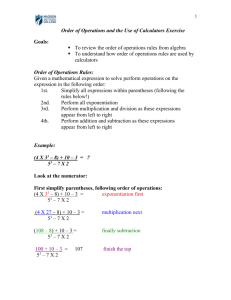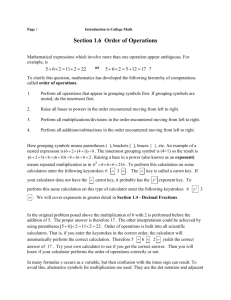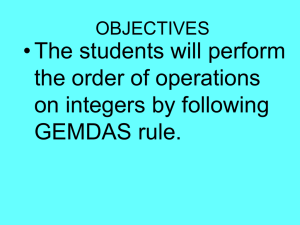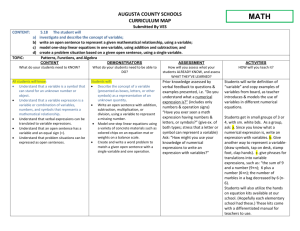Exponential Expressions and the Order of Operations
advertisement
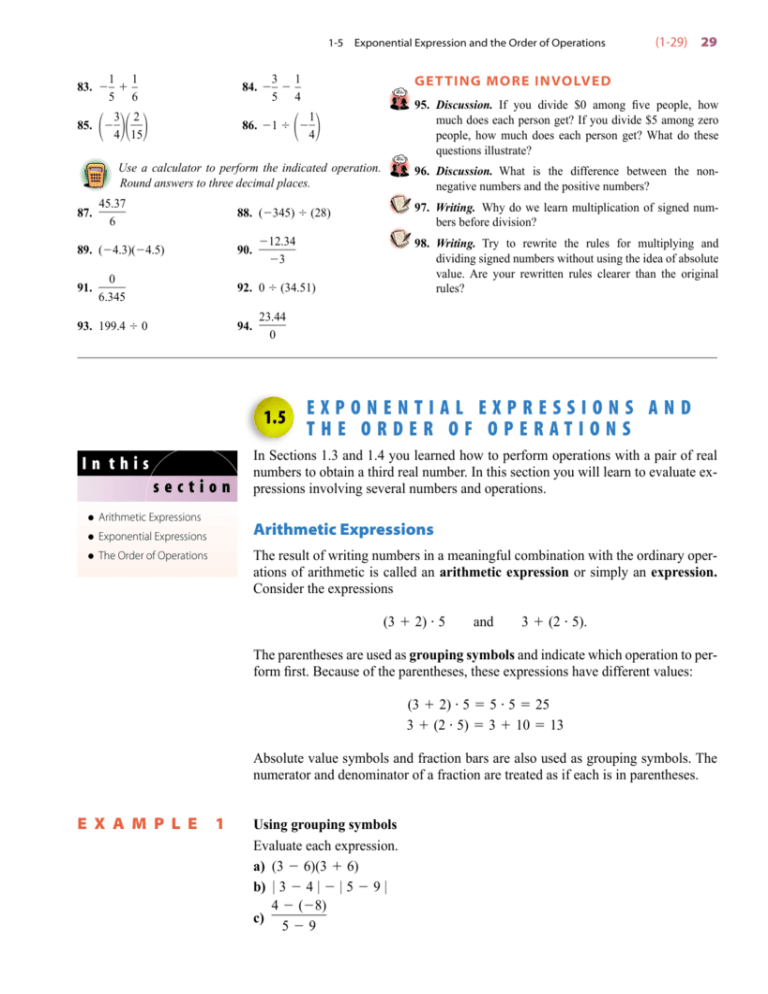
1-5 1 30 1 1 83. 5 6 3 2 85. 4 15 Exponential Expression and the Order of Operations 3 1 17 84. 5 4 20 1 86. 1 4 1 10 7.562 89. (4.3)(4.5) 0 91. 6.345 19.35 95. Discussion. If you divide $0 among five people, how much does each person get? If you divide $5 among zero people, how much does each person get? What do these questions illustrate? 4 93. 199.4 0 97. Writing. Why do we learn multiplication of signed numbers before division? 12.34 90. 3 98. Writing. Try to rewrite the rules for multiplying and dividing signed numbers without using the idea of absolute value. Are your rewritten rules clearer than the original rules? 23.44 94. 0 undefined 1.5 In this section ● Arithmetic Expressions ● Exponential Expressions ● The Order of Operations 96. Discussion. What is the difference between the nonnegative numbers and the positive numbers? 88. (345) (28) 12.321 4.113 92. 0 (34.51) 0 29 GET TING MORE INVOLVED Use a calculator to perform the indicated operation. Round answers to three decimal places. 45.37 87. 6 (1-29) 0 undefined EXPONENTIAL EXPRESSIONS AND THE ORDER OF OPERATIONS In Sections 1.3 and 1.4 you learned how to perform operations with a pair of real numbers to obtain a third real number. In this section you will learn to evaluate expressions involving several numbers and operations. Arithmetic Expressions The result of writing numbers in a meaningful combination with the ordinary operations of arithmetic is called an arithmetic expression or simply an expression. Consider the expressions (3 2) 5 and 3 (2 5). The parentheses are used as grouping symbols and indicate which operation to perform first. Because of the parentheses, these expressions have different values: (3 2) 5 5 5 25 3 (2 5) 3 10 13 Absolute value symbols and fraction bars are also used as grouping symbols. The numerator and denominator of a fraction are treated as if each is in parentheses. E X A M P L E 1 Using grouping symbols Evaluate each expression. a) (3 6)(3 6) b) 3 4 5 9 4 (8) c) 59 30 (1-30) Chapter 1 Real Numbers and Their Properties Solution a) (3 6)(3 6) (3)(9) Evaluate within parentheses first. 27 Multiply. b) 3 4 5 9 1 4 Evaluate within absolute value symbols. 14 Find the absolute values. 3 Subtract. 4 (8) 12 c) Evaluate the numerator and denominator. 59 4 3 Divide. ■ calculator close-up One advantage of a graphing calculator is that you can enter an entire expression on its display and then evaluate it. If your calculator does not allow built-up form for fractions, then you must use parentheses around the numerator and denominator as shown here. Exponential Expressions An arithmetic expression with repeated multiplication can be written by using exponents. For example, tip If you need help, do not hesitate to get it. Math has a way of building upon the past. What you learn today will be used tomorrow, and what you learn tomorrow will be used the day after. If you don’t straighten out problems immediately, then you can get hopelessly lost. If you are having trouble, see your instructor to find out what help is available. 2 2 2 23 and 5 5 52. The 3 in 23 is the number of times that 2 occurs in the product 2 2 2, while the 2 in 52 is the number of times that 5 occurs in 5 5. We read 23 as “2 cubed” or “2 to the third power.” We read 52 as “5 squared” or “5 to the second power.” In general, an expression of the form an is called an exponential expression and is defined as follows. Exponential Expression For any counting number n, a n a a a . . . a. study n factors We call a the base and n the exponent. The expression an is read “a to the nth power.” If the exponent is 1, it is usually omitted. For example, 91 9. E X A M P L E 2 Using exponential notation Write each product as an exponential expression. a) 6 6 6 6 6 b) (3)(3)(3)(3) 3 3 3 c) 2 2 2 1.5 Exponential Expressions and the Order of Operations Solution a) 6 6 6 6 6 65 b) (3)(3)(3)(3) (3)4 3 3 3 3 3 c) 2 2 2 2 E X A M P L E 3 (1-31) 31 ■ Writing an exponential expression as a product Write each exponential expression as a product without exponents. 5 3 b) (2)4 c) d) (0.1)2 a) y6 4 Solution a) y6 y y y y y y b) (2)4 (2)(2)(2)(2) 5 3 5 5 5 c) 4 4 4 4 2 d) (0.1) (0.1)(0.1) ■ To evaluate an exponential expression, write the base as many times as indicated by the exponent, then multiply the factors from left to right. E X A M P L E 4 Evaluating exponential expressions Evaluate. a) 33 calculator close-up You can use the power key for any power. Most calculators also have an x 2 key that gives the second power. Note that parentheses must be used when raising a fraction to a power. b) (2)3 Solution a) 33 3 3 3 9 3 27 b) (2)3 (2)(2)(2) 4(2) 8 4 2 2 2 2 2 c) 3 3 3 3 3 4 2 2 9 3 3 8 2 27 3 16 81 d) (0.4)2 (0.4)(0.4) 0.16 2 c) 3 4 d) (0.4)2 ■ Note that 33 9. We do not multiply the exponent and the base when evaluating an exponential expression. CAUTION 32 (1-32) study Chapter 1 tip Find out what help is available at your school. Accompanying this text are video tapes, solution manuals, and a computer tutorial. Around most campuses you will find tutors available for hire, but most schools have a math lab where you can get help for free. Some schools even have free one-on-one tutoring available through special programs. Real Numbers and Their Properties Be especially careful with exponential expressions involving negative numbers. An exponential expression with a negative base is written with parentheses around the base as in (2)4: (2)4 (2)(2)(2)(2) 16 To evaluate (24), use the base 2 as a factor four times, then find the opposite: (24) (2 2 2 2) (16) 16 We often omit the parentheses in (24) and simply write 24. So 24 (24) 16. To evaluate (2)4, use the base 2 as a factor four times, then find the opposite: (2)4 (16) 16 E X A M P L E 5 Evaluating exponential expressions involving negative numbers Evaluate. b) 104 a) (10)4 2 c) (0.5) d) (5 8)2 Solution a) (10)4 (10)(10)(10)(10) 10,000 b) 10 (104) 4 Use 10 as a factor four times. Rewrite using parentheses. (10,000) Find 104. 10,000 Then find the opposite of 10,000. c) (0.5) (0.5)(0.5) 2 Use 0.5 as a factor two times. (0.25) 0.25 d) (5 8) (3)2 2 helpful hint “Please Excuse My Dear Aunt Sally” is often used as a memory aid for the order of operations. Do Parentheses, Exponents, Multiplication and Division, then Addition and Subtraction. Evaluate within parentheses first. (9) Square 3 to get 9. 9 Take the opposite of 9 to get 9. ■ The Order of Operations To simplify writing of expressions, parentheses are often omitted as in the expression 3 2 5. When no parentheses are present, we agree to perform multiplication before addition. So 3 2 5 3 10 13. To evaluate expressions consistently, we follow an accepted order of operations. When no grouping symbols are present, we perform operations in the following order: 1.5 Exponential Expressions and the Order of Operations (1-33) 33 Order of Operations 1. Evaluate each exponential expression (in order from left to right). 2. Perform multiplication and division (in order from left to right). 3. Perform addition and subtraction (in order from left to right). “In order from left to right” does not mean to perform multiplication before division or addition before subtraction. It means to perform them from left to right. For example, 843236 and 9 3 5 6 5 11. E X A M P L E 6 calculator close-up Most calculators follow the same order of operations shown here. Evaluate these expressions with your calculator. Using the order of operations Evaluate each expression. b) 2 5 3 4 42 a) 23 32 8 c) 2 3 4 33 2 Solution a) 23 32 8 9 Evaluate exponential expressions before multiplying. 72 b) 2 5 3 4 42 2 5 3 4 16 Exponential expressions first 10 12 16 Multiplication second 14 Addition and subtraction from left to right 8 8 c) 2 3 4 33 2 3 4 27 2 2 24 27 4 1 Exponential expressions first Multiplication and division second Addition and subtraction from left to right ■ When grouping symbols are used, we perform operations within grouping symbols first. The order of operations is followed within the grouping symbols. E X A M P L E 7 Grouping symbols and the order of operations Evaluate. b) 3 7 3 4 a) 3 2(7 23) 958 c) 52 3(7) Solution a) 3 2(7 23) 3 2(7 8) Evaluate within parentheses first. 3 2(1) Multiply. 3 (2) 5 Subtract. b) 3 7 3 4 3 7 12 Evaluate within the absolute value symbols first. 3 5 Evaluate the absolute value. 35 2 Subtract. 34 (1-34) Chapter 1 Real Numbers and Their Properties 958 12 12 c) 3 52 3(7) 25 21 4 Numerator and denominator are treated as if in parentheses. ■ When grouping symbols occur within grouping symbols, we evaluate within the innermost grouping symbols first and then work outward. In this case, brackets [ ] can be used as grouping symbols along with parentheses to make the grouping clear. E X A M P L E 8 Grouping within grouping Evaluate each expression. a) 6 4[5 (7 9)] b) 2 3 (9 5) 3 Solution a) 6 4[5 (7 9)] 6 4[5 (2)] Innermost parentheses first 6 4[7] Next evaluate within the brackets. 6 28 Multiply. 22 Subtract. b) 2 3 (9 5) 3 2 3 4 3 Innermost grouping first 2 1 3 Evaluate within the first absolute value. 2 1 3 2 3 5 Evaluate absolute values. Multiply. Subtract. calculator close-up Graphing calculators can handle grouping symbols within grouping symbols. Since parentheses must occur in pairs, you should have the same number of left parentheses as right parentheses. WARM-UPS True or false? Explain your answer. (3)2 6 False (5 3)2 4 True 5 6 2 (5 6) 2 5 33 8 False 6 0 9. 6 False 2 2 1. 3. 5. 7. False 5 3 2 4 False 5 6 5 6 False (2 3)2 22 32 False (5 3)3 8 True 66 10. 0 True 2 2. 4. 6. 8. ■ 1.5 1. 5 Exponential Expressions and the Order of Operations EXERCISES Reading and Writing After reading this section write out the answers to these questions. Use complete sentences. 1. What is an arithmetic expression? An arithmetic expression is the result of writing numbers in a meaningful combination with the ordinary operations of arithmetic. 2. What is the purpose of grouping symbols? The purpose of grouping symbols is to indicate the order in which to perform operations. 3. What is an exponential expression? An exponential expression is an expression of the form an. 4. What is the difference between 36 and (3)6? The value of 36 is negative while the value of (3)6 is positive. 5. What is the purpose of the order of operations? The order of operations tells us the order in which to perform operations when grouping symbols are omitted. 6. What were the different types of grouping symbols used in this section? Grouping symbols used in this section were parentheses, absolute value bars, and the fraction bar. Evaluate each expression. See Example 1. 7. (4 3)(5 9) 4 8. (5 7)(2 3) 10 9. 3 4 2 4 10. 4 9 3 5 1 13 7 (9) 8 2 11. 8 12. 3 35 1 1 13. (6 5)(7) 7 14. 6 (5 7) 29 15. (3 7) 6 16 16. 3 (7 6) 4 17. 16 (8 2) 4 18. (16 8) 2 1 Write each product as an exponential expression. See Example 2. 19. 4 4 4 4 44 20. 1 1 1 1 1 15 4 21. (5)(5)(5)(5) (5) 22. (7)(7)(7) (7)3 3 23. (y)(y)(y) (y) 24. x x x x x x 5 3 3 3 3 3 3 5 y y y y y 4 25. 26. 7 7 7 7 7 7 2 2 2 2 2 Write each exponential expression as a product without exponents. See Example 3. 27. 53 5 5 5 28. (8)4 (8)(8)(8)(8) 2 29. b b b 30. (a)5 (a)(a)(a)(a)(a) 22222 13 13 13 13 32. 12 12 12 12 1 31. 2 (1-35) 35 1 5 1 1 1 1 3 33. (0.22)4 (0.22)(0.22)(0.22)(0.22) 34. (1.25)6 (1.25)(1.25)(1.25)(1.25)(1.25)(1.25) Evaluate each exponential expression. See Examples 4 and 5. 35. 34 81 36. 53 125 37. 09 0 12 4 0 39. (5) 625 40. (2) 5 32 38. 0 3 2 42. (12) 144 43. (10)5 100,000 41. (6) 216 6 45. (0.1)3 46. (0.2)2 44. (10) 1,000,000 0.001 0.04 1 3 1 2 3 8 1 2 1 47. 48. 49. 2 8 3 2 4 27 2 2 4 2 2 50. 51. 8 64 52. 7 49 3 9 54. (7)3 343 53. (8)4 4096 3 56. (6 9)4 81 55. (7 10) 27 2 2 58. (34) (52) 56 57. (2 ) (3 ) 13 Evaluate each expression. See Example 6. 59. 32 22 36 60. 5 102 500 61. 3 2 4 6 18 62. 5 4 8 3 44 64. 32 5(1)3 14 63. (3)3 23 19 2 66. 18 92 33 21 65. 21 36 3 17 3 2 68. 2 5 32 4 0 1 67. 3 2 5 2 44 8 12 70. 4 2 6 33 69. 2 3 5 23 2 3 18 25 Evaluate each expression. See Example 7. 71. (3 42)(6) 78 72. 3 (23 4) 5 180 3 74. 5 2(3 2)3 7 73. (3 2 6) 0 75. 2 5(3 4 2) 27 76. (3 7)(4 6 2) 32 77. 3 2 5 6 1 78. 3 6 7 3 12 79. (32 5) 3 2 8 8 80. 4 6 3 6 9 17 346 6 (8)2 81. 7 82. 29 7 10 3 (1) 32 2 · 4 7 9 32 1 83. 11 84. 2 973 30 2 4 2 Evaluate each expression. See Example 8. 85. 3 4[9 6(2 5)] 111 86. 9 3[5 (3 6)2] 3 87. 62 [(2 3)2 10] 21 88. 3[(2 3)2 (6 4)2] 15 89. 4 5 3 (32 7) 1 90. 2 3 4 (72 62) 29 91. 2 3 (7 3) 9 11 92. 3 (2 4)3 2 4 25 Evaluate each expression. Use a calculator to check. 93. 1 23 9 94. (1 2)3 27 2 96. (2)2 4(2)(3) 20 95. (2) 4(1)(3) 16 98. 32 4(2)(3) 33 97. 42 4(1)(3) 28 2 99. (11) 4(5)(0) 121 100. (12)2 4(3)(0) 144 (1-36) Chapter 1 Real Numbers and Their Properties 101. 52 3 42 73 102. 62 5(3)2 81 103. [3 2(4)]2 25 104. [6 2(3)]2 144 105. 1 1 0 106. 4 1 7 2 3 (7) 4 (4) 107. 2 108. 5 2 2 35 109. 3(1)2 5(1) 4 12 110. 2(1)2 5(1) 6 13 111. 5 22 34 82 112. 5 (2)2 32 0 2 113. 2 9 6 54 114. 8 3 5 42 1 22 115. 32 5[4 2(4 9)] 79 116. 2[(3 4)3 5] 7 19 117. 1 5 5 (9 1) 24 118. 6 3 7 7 (5 2) 19 Use a calculator to evaluate each expression. 3.22 4(3.6)(2.2) 41.92 (4.5)2 4(2.8)(4.6) 31.27 (5.63)3 [4.7 (3.3)2] 184.643547 9.83 [1.2 (4.4 9.6)2] 967.032 3.44 (8.32) 123. 8.0548 6.89 5.43 4.56 3.22 124. 0.8021 3.44 (6.26) 119. 120. 121. 122. 350 300 250 0 5 10 15 Years after 1998 20 FIGURE FOR EXERCISE 125 a) Find the predicted population in the year 2010 to the nearest tenth of a million people. 123.3 million b) Will the U.S. or Mexico have the greater increase in population between the years 1998 and 2010? (See the previous exercise.) U.S. GET TING MORE INVOLVED Solve each problem. 125. Population of the United States. In 1998 the population of the United States was 270.1 million (U.S. Census Bureau, www.census.gov). If the population continues to grow at an annual rate of 0.86%, then the population in the year 2010 will be 270.1(1.0086)12 million. Find the predicted population in 2010 to the nearest tenth of a million people. 299.3 million 126. Population of Mexico. In 1998 the population of Mexico was 97.2 million (World Resources 1997–1998, www.wri.org). If Mexico’s population continues to grow at an annual rate of 2.0%, then the population in the year 2010 will be 97.2(1.02)12 million. 1.6 Population of U.S. Growth rate: 0.86% Population (millions) 36 127. Discussion. Which operation symbols are used also as grouping symbols? The fraction bar is used as a grouping symbol and an operation symbol. Also absolute value and square root act as grouping symbols and indicate operations. 128. Discussion. What is wrong with each of the following expressions? a) 6(4 (3 (5)) 5 (7 b) (4 6)(5 3[6 4) 8] c) 3 2) a) Too few closing parentheses. b) Only a right parenthesis occurs inside the brackets. c) Left parenthesis occurs in numerator and right parenthesis occurs in denominator. 129. Discussion. How do the expressions (5)3, (53), 53, (5)3, and 1 53 differ? (5)3 (53) 53 1 53 and (5)3 53 130. Discussion. How do the expressions (4)4, (44), 44, (4)4, and 1 44 differ? (44) 44 (4)4 1 · 44 and (4)4 44 ALGEBRAIC EXPRESSIONS In Section 1.5 you studied arithmetic expressions. In this section you will study expressions that are more general—expressions that involve variables. Identifying Algebraic Expressions Since variables (or letters) are used to represent numbers, we can use variables in arithmetic expressions. The result of combining numbers and variables with the ordinary operations of arithmetic (in some meaningful way) is called an algebraic
